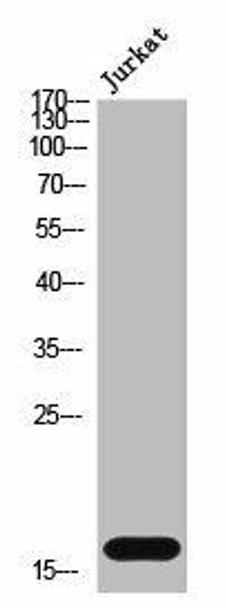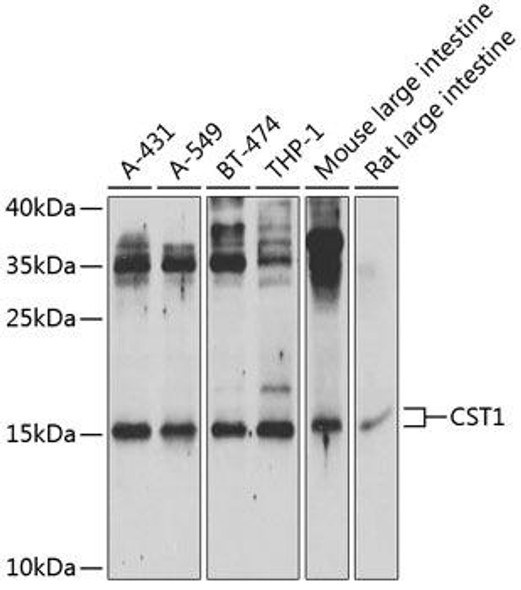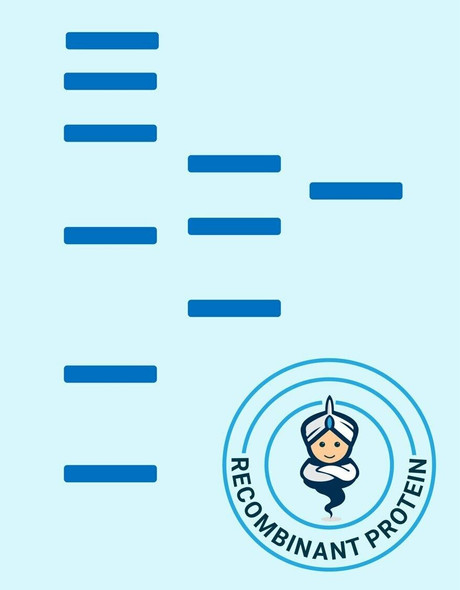CST1 Antibody (PACO02504)
- SKU:
- PACO02504
- Product type:
- Antibody
- Reactivity:
- Human
- Host Species:
- Rabbit
- Isotype:
- IgG
- Application:
- ELISA
- Application:
- WB
- Application:
- IHC
- Application:
- IF
- Antibody type:
- Polyclonal
- Conjugation:
- Unconjugated
Frequently bought together:
Description
| Antibody Name: | CST1 Antibody |
| Antibody SKU: | PACO02504 |
| Size: | 50ug |
| Host Species: | Rabbit |
| Tested Applications: | ELISA, WB, IHC, IF |
| Recommended Dilutions: | IHC:1:100-1:300, IF:1:200-1:1000 |
| Species Reactivity: | Human |
| Immunogen: | synthesized peptide derived from the Internal region of human Cystatin SN. |
| Form: | Liquid |
| Storage Buffer: | Liquid in PBS containing 50% glycerol, 0.5% BSA and 0.02% sodium azide. |
| Purification Method: | The antibody was affinity-purified from rabbit antiserum by affinity-chromatography using epitope-specific immunogen. |
| Clonality: | Polyclonal |
| Isotype: | IgG |
| Conjugate: | Non-conjugated |
| Synonyms: | CST1; Cystatin-SN; Cystain-SA-I; Cystatin-1; Salivary cystatin-SA-1 |
| UniProt Protein Function: | CST1: Human saliva appears to contain several cysteine proteinase inhibitors that are immunologically related to cystatin S but that differ in their specificity due to amino acid sequence differences. Cystatin SN, with a pI of 7.5, is a much better inhibitor of papain and dipeptidyl peptidase I than is cystatin S, although both inhibit ficin equally well. Belongs to the cystatin family. |
| UniProt Protein Details: | Protein type:Secreted; Secreted, signal peptide Chromosomal Location of Human Ortholog: 20p11.21 Cellular Component: extracellular space Molecular Function:cysteine protease inhibitor activity Biological Process: detection of chemical stimulus involved in sensory perception of bitter taste |
| NCBI Summary: | The cystatin superfamily encompasses proteins that contain multiple cystatin-like sequences. Some of the members are active cysteine protease inhibitors, while others have lost or perhaps never acquired this inhibitory activity. There are three inhibitory families in the superfamily, including the type 1 cystatins (stefins), type 2 cystatins and the kininogens. The type 2 cystatin proteins are a class of cysteine proteinase inhibitors found in a variety of human fluids and secretions, where they appear to provide protective functions. The cystatin locus on chromosome 20 contains the majority of the type 2 cystatin genes and pseudogenes. This gene is located in the cystatin locus and encodes a cysteine proteinase inhibitor found in saliva, tears, urine, and seminal fluid. [provided by RefSeq, Jul 2008] |
| UniProt Code: | P01037 |
| NCBI GenInfo Identifier: | 311033460 |
| NCBI Gene ID: | 1469 |
| NCBI Accession: | P01037.3 |
| UniProt Secondary Accession: | P01037,Q96LE6, Q9UCQ6, |
| UniProt Related Accession: | P01037 |
| Molecular Weight: | 141 |
| NCBI Full Name: | Cystatin-SN |
| NCBI Synonym Full Names: | cystatin SN |
| NCBI Official Symbol: | CST1 |
| NCBI Protein Information: | cystatin-SN; cystatin 1; cystatin-1; cystain-SA-I; cystatin SA-I; salivary cystatin-SA-1; cysteine proteinase inhibitor, type 2 family |
| UniProt Protein Name: | Cystatin-SN |
| UniProt Synonym Protein Names: | Cystain-SA-I; Cystatin-1; Salivary cystatin-SA-1 |
| Protein Family: | Cystatin |
| UniProt Gene Name: | CST1 |
| UniProt Entry Name: | CYTN_HUMAN |










